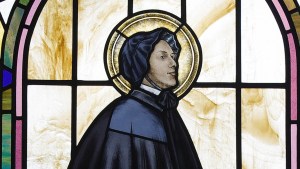Born and raised in a prominent Episcopal family in the United States, Elizabeth Ann Seton had no intention of becoming Catholic. However, when she traveled to Italy and was immersed into a thriving Catholic culture, she began to have second thoughts about her faith.
While there were many factors that led to her conversation to Catholicism, one of them was her fascination with the Eucharist.
In the book Lives of the Catholic Heroes and Heroines of America, published in 1880, author John Murray relates several stories from Seton’s life that highlight her curiosity with the sacrament.
For example, one time she attended Mass with a few friends and was struck by the solemn act of consecration, which was irreverently interrupted by one of her friends.
A young Englishman who was present observed to her at the very moment of the elevation, “This is what they call their Real Presence!” “My very heart,” says Mrs. Seton, “trembled with pain and sorrow for his unfeeling interruption of their sacred adoration; for all around was dead silence, and many were prostrated. Involuntarily I bent from him to the pavement, and thought secretly on the words of St. Paul with starting tears, ‘They discern not the Lord’s Body;’ and the next thought was, how should they eat and drink their own damnation for not discerning It, if indeed It is not there?”
She knew there was something special about the Eucharist and wondered to herself if it was true that God himself was present under the appearance of bread and wine.
Slowly she became even more acquainted with the teachings of the Catholic Church and her heart started to believe them.
“When they carry the Blessed Sacrament under my window, while I feel the full loneliness and sadness of my case, I cannot stop my tears at the thought. ‘My God, how happy I should be, now so far away from all so dear, if I could find You in the church, as they do (for there is a chapel in the very house of Mr. Filicchi). How many things I would say to You of the sorrows of my heart, and the sins of my life! The other day, in a moment of excessive distress, I fell on my knees, without thinking, when the Blessed Sacrament passed by, and cried in an agony to God to bless me, if He was there; that my whole soul desired only Him.”
Furthermore, she was struck by the fact that many Catholics would attend daily Mass, while most other Christian churches would close their doors between Sundays.
Many other events and conversations contributed to her ultimate conversion to Catholicism, which was completed in 1805 when she returned to New York.
She would go on to become a pivotal leader in the Catholic Church in America and would feed her faith through daily reception of Holy Communion.

Read more:
Here’s what to do during spiritual dryness, according to St. Elizabeth Ann Seton

Read more:
4 Incredible Eucharistic miracles that defy scientific explanation

